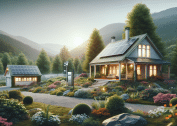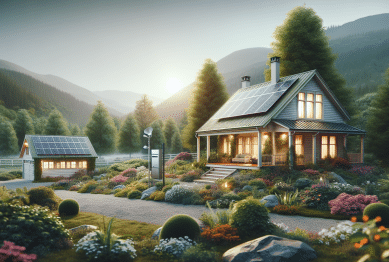Discover surprisingly effective ideas for transforming small garden spaces into lush, functional retreats. This guide covers layout tips, vertical gardening, container solutions, and how lighting can reinvent your home’s outdoor areas. Explore new ways to maximize every inch and enjoy a thriving garden no matter the space.
Reimagining Layouts for Small Gardens
Designing for small garden spaces requires intention and creativity. Traditional layouts can feel cramped, often leaving areas underutilized. By thinking vertically and layering plant beds, these spaces become adaptable. Using defined paths with stepping stones or gravel adds structure. Setting clear borders between planting zones and sitting areas provides clarity, making a garden appear larger than it is. This approach is not just about beauty; it gives every square foot a purpose, from seating nooks to raised beds, all working together in harmony. The result is a functional space that feels open despite its compact footprint, ensuring your home garden maximizes its full potential for relaxation and enjoyment.
In narrow plots or patios, zoning becomes a vital trick. Grouping plants according to function—herbs near the kitchen, flowers along the path, and shrubs for privacy—creates order and accessibility. Clever use of levels with terraces or built-in seating can further break monotony. Small garden owners often discover that repetition—using the same plant or paver across sections—brings unity and a sense of calm. Mirrored features, such as matching planters on each side of an entry, visually widen the area and create gentle symmetry. Even the direction of paving or decking can stretch the eye, boosting apparent size.
Flow is crucial for small landscapes. Designing winding paths or gently curving beds avoids harsh lines, allowing visitors to linger and explore. Multi-functional spaces, like a bench that also houses tools beneath its seat, support both form and storage. Experimenting with focal points—a single sculpture or colorful container—draws attention and lends a sense of personality. Layering materials and textures, such as pebbles, wood, or mulch, invites curiosity and direct interaction with the setting. A thoughtful layout makes the space intuitive, welcoming, and surprisingly versatile, regardless of whether the outdoor area surrounds a city apartment or suburban home.
Vertical Gardening: Growing Up, Not Out
With limited square footage, vertical gardening becomes an invaluable strategy. Installing trellises, wall planters, or free-standing frames allows gardeners to train vines and climbing plants off the ground. This not only saves space but can transform bare walls and fences into thriving, beautiful green backdrops. Vertical gardens also act as natural privacy screens, allowing you to shield small patios from neighbors. Recent innovations include modular planting systems and pocket gardens that make the most of even the tiniest spots, encouraging creativity and efficient use of resources.
A living wall, filled with herbs or flowering plants, brings an explosion of color and fragrance at eye level. These installations are perfect for edible gardens in urban environments, making it easy to harvest fresh produce while conserving space. Lightweight containers mounted on vertical surfaces help with water drainage and root management. By introducing vertical layers, gardeners achieve the impression of lush abundance even where soil is scarce. Whether using traditional climbing roses or modern hydroponic panels, vertical gardens create dimension, boost biodiversity, and stimulate the senses.
Incorporating hanging baskets and stacked shelving multiplies planting capacity. Tiered plant displays, made from wood or recycled materials, invite experimentation with color combinations and plant varieties. When paired with trailing species—like nasturtiums, ivy, or strawberries—these structures become dynamic garden features. For those with mobility concerns, vertical setups can also reduce the need to bend or kneel. Ultimately, vertical gardening opens new possibilities for urban dwellers, condo owners, or anyone wishing to experience lush foliage and blooms within their home’s footprint.
Container Solutions for Flexibility and Style
Container gardening is a smart technique for maximizing versatility in small or uneven areas. With mobile pots and planters, gardeners can shift, experiment, and refresh layouts as needed. This method allows for microclimates within a small area, supporting a diverse range of species—from sun-seeking tomatoes to shade-loving ferns. The key to success lies in selecting appropriately sized containers with ample drainage, ensuring healthy root growth. Arranging containers at various heights, such as on stands or shelves, creates depth and intrigue, guiding the eye around the garden’s composition.
Choosing containers is about more than function—style can unify or accent a theme. Cement pots offer modern simplicity, while terracotta adds rustic warmth. Brightly colored planters become focal points amid greenery. Mixing materials like metal, ceramic, and recycled plastics keeps the environment lively. Small gardens benefit from cluster arrangements; grouping planters in odd numbers or elevating certain vessels with bricks creates balance and dimension. This approach also accommodates experimentation—seasonal flower swaps, edible herbs, or succulents—without overhauling the entire space.
One key benefit of containers is control over growing mediums and moisture levels, which is critical on patios and rooftops where soil may be poor or absent. Containers can be moved for optimal light, brought indoors during harsh weather, or grouped to conserve water. For renters or seasonal gardeners, pots offer ultimate flexibility. Moreover, containers become living art, offering ever-changing displays that delight visitors and residents alike. Even the tiniest balcony or doorstep can host a vibrant garden with this method.
Clever Lighting to Enhance Mood and Functionality
Outdoor lighting is often overlooked yet profoundly impacts small garden spaces. Thoughtfully placed lights can extend time outdoors, highlight focal points, and make a compact area inviting after sunset. From solar path lights to string bulbs overhead, different lighting types create drama or gentle ambience as desired. Uplighting architectural plants, such as tall grasses or bamboo, adds depth and makes the garden feel larger at night. Meanwhile, lanterns or battery-operated fairy lights hung from trellises or pergolas encourage evening relaxation and quiet conversation.
Safety is another essential benefit of strategic lighting. Illuminating steps, edges, or water features prevents accidents. Sensor-based or timer-controlled lights offer both security and convenience, ensuring paths remain visible without constant adjustment. In small outdoor kitchens or grill zones, task lighting ensures cooking can occur comfortably at any hour. By enhancing both aesthetics and usability, lighting solutions support year-round enjoyment regardless of the garden’s size or climate.
Lighting schemes are now more energy-efficient thanks to LED and solar-powered innovations. Flexible strip lights can border raised beds or containers, while stake lights define garden boundaries or mark gathering spaces. Experimenting with warm or cool bulbs changes the mood subtly. Even if a small backyard receives little natural sunlight, creative illumination ensures every corner feels welcoming after dark. Lighting quickly becomes both a practical upgrade and a transformative design feature within home garden spaces.
Low-Maintenance Choices for Lasting Impact
Balancing beauty and upkeep is crucial in any compact home garden. Prioritizing drought-tolerant, pest-resistant plants helps reduce time spent on care. Using ground covers such as creeping thyme or sedum controls weeds and fills gaps attractively, while slow-growing shrubs or dwarf varieties minimize pruning. Choosing native plants adapted to local conditions ensures year-round color and minimal resource demands. Mulching beds retains moisture and supports soil health, which is especially helpful for busy homeowners or those seeking more leisure from their garden.
Automated watering systems simplify routine tasks, preventing over- or under-watering in small, densely planted areas. Drip irrigation or self-watering containers conserve water, a significant advantage in urban or drought-prone regions. Many gardeners now explore permaculture principles—using plants and layouts designed for resilience—to encourage natural growth cycles without chemical intervention. Decorative features like gravel paths or rock gardens further cut back on mowing and ongoing care. The right mix of hardy flora and smart infrastructure leads to lasting, stress-free appeal.
Low-maintenance gardens leave more time for enjoyment. Even the smallest yard can become a haven for pollinators and wildlife with the inclusion of bee-friendly blooms or birdbaths. Edible landscaping, mixing fruit bushes and perennial herbs, delivers both beauty and bounty without extra effort. Small water features, container ponds, or rockeries bring tranquility and invite exploration year-round. By combining thoughtful plant choices with tailored features, homeowners create gardens that reward the senses yet require little beyond seasonal adjustments.
Personalizing and Enjoying Your Outdoor Retreat
Small gardens thrive on individuality. Consider expressing your style through painted fences, repurposed vintage items, or custom mosaics. Wind chimes, sculpture, or water elements bring character that reflects your experiences and favorite places. Incorporating seating nooks or a cozy hammock transforms the space into an inviting sanctuary for reading, meditation, or evening gatherings. Even a single statement piece—a bold plant or handcrafted artwork—can instill a sense of place, making the garden uniquely yours.
Engaging with the space is vital for connection and well-being. Routine interaction—watering, harvesting, or simply observing—encourages mindfulness and appreciation of the slow changes throughout the seasons. Community activities, such as seed swaps or garden clubs, offer a way to share successes and inspire new ideas. Documenting your progress, whether through photography or journaling, celebrates growth and anchors memories, deepening your relationship with the space.
Outdoor retreats, regardless of size, boost quality of life. Nature exposure reduces stress and fosters creativity, while shared meals or gatherings build connections with friends and family. By blending practical strategies with personal touches, small gardens become favorite destinations from spring’s first blooms to winter’s quiet. Every effort, from planting a single container to building a vertical wall, is a step toward a more vibrant, enjoyable home.
References
1. Royal Horticultural Society. (n.d.). Small Gardens. Retrieved from https://www.rhs.org.uk/garden-inspiration/small-gardens
2. University of Illinois Extension. (n.d.). Container Gardening. Retrieved from https://extension.illinois.edu/containers
3. Royal Horticultural Society. (n.d.). Vertical Gardening. Retrieved from https://www.rhs.org.uk/advice/profile?PID=829
4. Cornell University Cooperative Extension. (n.d.). Low Maintenance Gardens. Retrieved from http://cceonondaga.org/resources/low-maintenance-gardening
5. University of California Division of Agriculture and Natural Resources. (n.d.). Lighting the Landscape. Retrieved from https://ucanr.edu/sites/gardenweb/landscaping/landscape-lighting/
6. American Society of Landscape Architects. (n.d.). Enjoy your Garden. Retrieved from https://www.asla.org/publications.aspx









